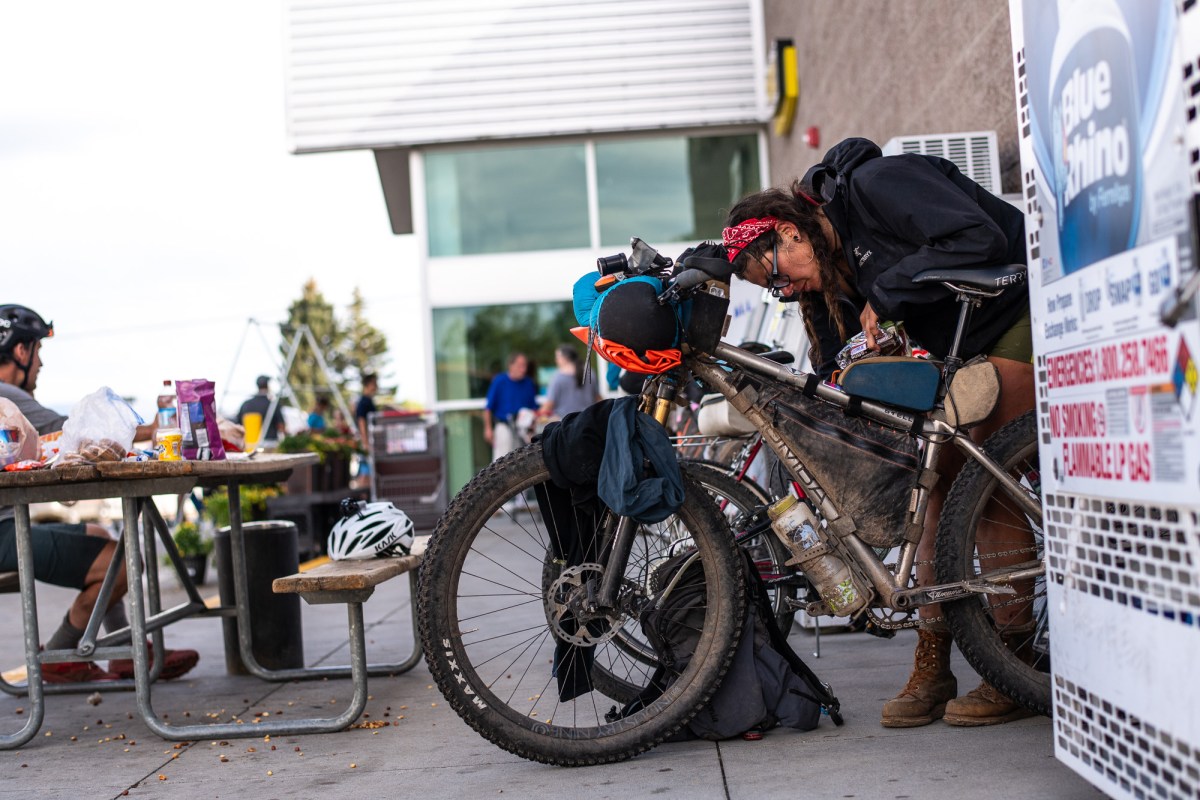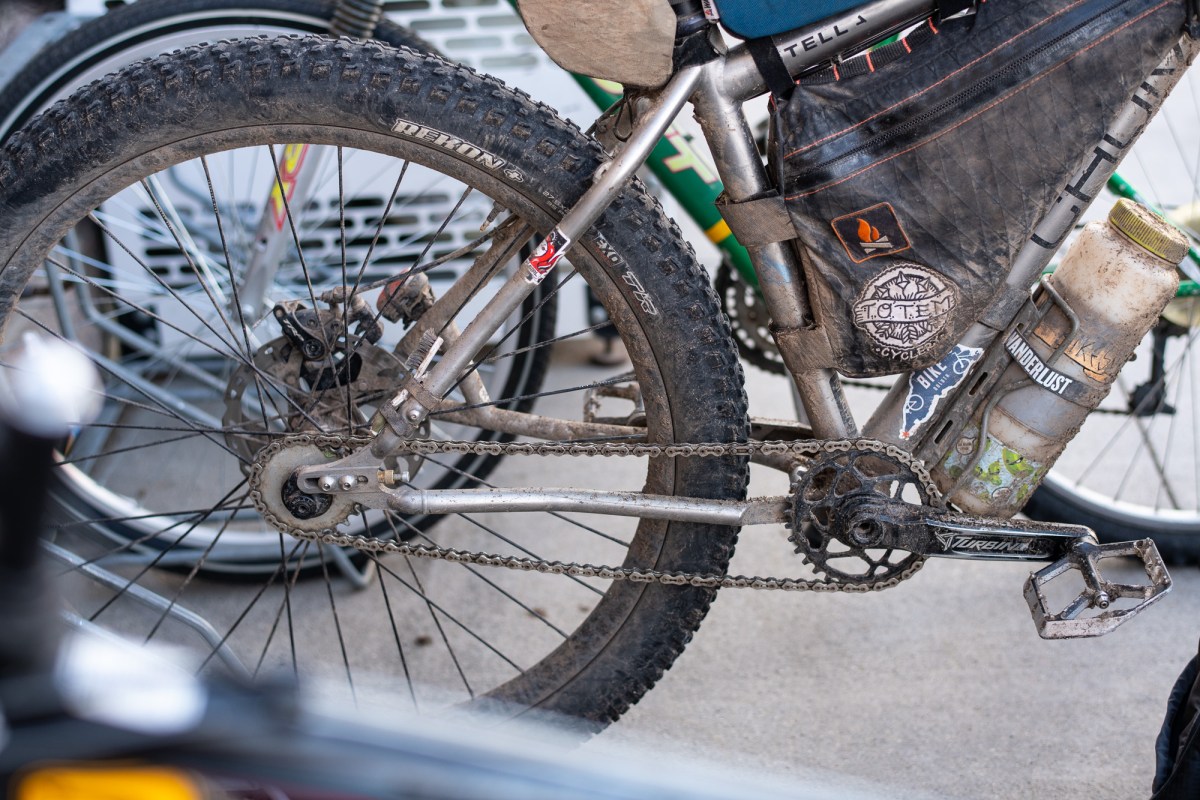On September 16, 2017, Alexandera Houchin woke up from a fitful sleep cocooned in a sleeping bag and a blue tarp on the side of the road. Her body felt sluggish, numb from the sub-freezing Idaho air. She fumbled with her watch to check the time: 1:30am It was her 28th birthday. It was also the fourth day of the Smoke ‘n’ Fire 400, a mountain bike route through Idaho’s Sawtooth Range and Houchin’s first-ever bike race.
Houchin found a few twigs and dry pine needles. Using flint, shredded toilet paper and a glob of petroleum jelly, she lit a small fire. She stuck a twig—her candle—into the flames and then into a coconut date roll—her cake. Saddle-sore, cold and utterly spent, it would take Houchin another 24 hours to finish that race. But even in the depths of her exhaustion, Houchin had never felt more alive. She blew out her twig-candle and made a pact to complete eight races in her 28th year, a goal she dubbed the “8-in-28.”
Houchin, now 30 years old, is an icon of endurance bike racing. Since finishing third from last in the Smoke ‘n’ Fire, Houchin has racked up some impressive results. In 2018—the “8-in-28” year—Houchin won first place for woman in the Tour Divide, a 2,700-mile mostly gravel race that largely follows the Great Divide Mountain Bike Route from Banff, Canada to Antelope Wells, New Mexico. This year, she defended her Tour Divide women’s title, this time on a singlespeed—a bike with only one gear—and simultaneously set a new women’s singlespeed record at 18 days, 20 hours and 26 minutes. (Lael Wilcox still holds the women’s overall speed record at 15 days, 10 hours and 59 minutes.) Averaging 120 to 150 miles per day, Houchin shaved a full day off of the previous record. Just one month after the Divide, Houchin was the first women’s finisher in the Colorado Trail Race, a 500-mile singletrack race from Denver to Durango, again on her singlespeed.
All the while Houchin has accumulated an adoring fan base of “dot watchers,” people who follow riders’ SPOT tracking devices during races, sometimes intersecting racers to cheer them on in person or share a few miles in the saddle. While Houchin doesn’t use social media, she does keep an infrequently updated yet soulful blog. Through her intimate blog posts and on-trail encounters, Houchin’s candor and no-frills style (her riding kit of choice includes a pair of steel toe boots and jean shorts) have only snowballed the praise surrounding her race finishes. As a Native American whose broad-shouldered body type she describes as an “apple on two toothpicks,” Houchin says she initially felt dissonance with the bike industry. But through the unconditional support of those fans and fellow riders, she says the endurance cycling community now feels as close as any family.
“When I first started cycling I really felt like I didn’t fit in,” she says. “People don’t acknowledge me as an athlete because I don’t look like one. As inclusive as it is once you get involved in the community, I still feel like it’s not always inclusive. You have to prove yourself, and I don’t know if that’s a good or bad thing, because sometimes proving yourself helps you learn more about yourself than you thought you knew.”

Photo Credit: Eddie Clark

Photo Credit: Eddie Clark
As a young girl, Houchin struggled with her weight and her sense of self-worth. She grew up in a trailer park in Janesville, Wisconsin, with her divorced father. By the time she graduated from high school, she weighed over 300 pounds.
“After passing my last gym class with a ‘D,’ I promised myself this one thing,” Houchin writes on her blog. “I’d never embarrass myself with exercise again.”
After high school Houchin moved away to Madison, Wisconsin, but even in that new environment, that age-old shame about her body remained. Around the same time Houchin relocated, her mother moved to the Fond du Lac Reservation near Cloquet, Minnesota, to reconnect with her Ojibwe roots and her biological mom. Houchin’s mother was a child in the Indian Adoption Project, a federal program that placed First Nation children into white families. Houchin says she supported her mother’s decision, but was left grappling to define a sense of place and belonging.
“It was hard on our family for awhile,” she says. “She left our home while my sister and brother were still in school. I had huge identity questions [like] what does it mean to be Native? Why did my mom leave?”
For Houchin, the search for those answers manifested themselves in an increasingly unhealthy relationship with food. She became obsessed with losing weight to the point that she was eventually diagnosed with an eating disorder. In need of transportation to and from work, Houchin’s grandparents gave her a heavy, 10-speed Schwinn. The bike was her only vehicle. At first, the 10-mile one-way commute took her 2 hours to ride, but in that effort—and despite her misgivings about exercise—she found freedom and started to acknowledge that food was necessary for fueling her body.
When Houchin’s bike was stolen, she bought another on the internet not knowing it was a fixed gear bicycle, which is a singlespeed with no freewheel (i.e., no coasting) and no brakes. With limited financial resources, Houchin stuck with her fixie. Her skills on the bike landed her a job at a sandwich shop, where she worked bike delivery for a few years. Later, she doubled her shifts, picking up work as a bike courier for the city of Madison. In 2012, she joined the Budget Bicycle Center team where she trained and worked as a mechanic for 3 years. It was there that she prepared for the first of what would be many bicycle tours.
She rode some 400 miles north to the westernmost tip of Lake Superior to visit her mother and to discover, for herself, what it meant to be Ojibwe. After three weeks on the reservation, where she found women who, like her, had “big shoulders and stick legs,” Houchin pointed her wheels southwest, bound for Boulder, Colorado. She arrived a few weeks later having biked and hitchhiked and, in places not rideable, hike-a-biked over 1,000 miles.
“It just awoke such an intimate part of my soul,” she says of that first tour. “I hated myself for so long. The bike changed everything. Without the bike, I certainly would not like myself the way I do. I love myself. I really do, which is honestly something I’m super proud to say. It took me a long time and a lot of miles to get here.”
She continued touring every summer, surviving on Clif Bars and peanut butter smeared on tortilla wraps, saving just enough money in her bank account to get herself and her bike home. Whenever she needed something—a ride to the airport, help shipping her bike, a couch to crash on—she reached out to the bike community often through Warmshowers, an online network for touring cyclists. Time and again, strangers helped her, rode with her and, during races, rooted for her.
While touring and racing long distances have some inherent differences, Houchin takes the same measured approach for races as she has for touring. She doesn’t overwhelm herself with the hundreds or thousands of miles ahead of her. Instead, she takes each race one day, one mile, one pedal stroke at a time.
At this year’s Dirty Kanza Extra Large, a 350-mile dirt road challenge in the Flint Hills of Kansas, Houchin snapped her pedal off 65 miles from the finish. It took her over 5 hours until she was able to locate a replacement—donated by a racer who had quit—but she still finished before the time cut-off.
During the 2019 Tour Divide, a rainstorm caught Houchin in Wyoming’s Great Basin. Fast-rolling dirt an hour prior deteriorated into soul-sucking mud. For 10 hours she trudged on foot, pushing her bike because the route was unrideable. But when other top Tour Divide contenders scratched from the race due to course conditions, Houchin stayed in the game.
In this year’s Colorado Trail Race, Houchin fell and fractured her ribs. Even breathing was painful. The following day, she spent 2 hours climbing more than 1,000 feet and descending 500 feet in the wrong direction. She retraced her route to get back on track and still finished first in the women’s field.
The first time Houchin raced the Tour Divide and the Colorado Trail back in 2018, she rode a geared bike. This year, she decided to switch to a singlespeed for the mechanical simplicity but also for the reminder that she’s tougher, stronger and more capable than she sometimes thinks.
“A lot of biking has been coming to terms with my weight and the way I look,” she says. “[Riding a singlespeed] is like walking up stairs all day long at the same speed. Slow and steady. It’s like, ‘This is what you got, let’s see what you can do with it,’ which is how I look at my body now. This is the body I was given, and this is all I have to work with. And yeah, it might not look the way I want it to, but it’s done everything I’ve asked it to. That’s not something you can hate.”
In blog entries, Houchin is forthcoming about her struggle not only to love her body but to also embrace the word “athlete,” an identity she did not associate with until veteran Tour Divide racer Jay Petervay called her one during the 2018 Tour Divide. She writes honestly about her journey—from loathing “those damn thighs [I] used to curse,” to marveling at their power—and as a result, she has been able to inspire cyclists battling their own doubts and insecurities.
“I think she’s often underestimated,” says Vince Colvin, a spokesperson from one of Houchin’s partner brands. “Since she doesn’t prescribe to what people think an athlete is with the way she dresses and the gear she chooses, it’s not the image people expect to win. She stays true to her own values when she’s racing and I think that, alongside of her originality, really resonates with a lot of people.”
For Houchin, the feeling is mutual. After 2 years of competing in long-distance bike races, she says it’s the community of endurance cyclists—from seasoned weekend warriors to first-timers—that keep her inspired to keep pushing her limits.
“I don’t know if I would be able to get such an intimate picture of a human without riding bikes,” she says. “These long-distance rides bring vulnerability. They fast-forward friendships 10 years. We talk about our feelings, our fears, our exhaustion. We have so much more in common than we think. We’re racing, but it’s like a silent competition. It’s so weird and unspoken and beautiful. The bike was my escape and then it turned into my freedom. I still cry at almost every mountain pass.”
